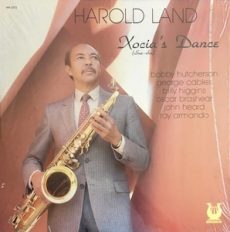
Requisites
Xocia’s Dance (Sue-sha’s Dance) ~ Harold Land | By Eddie Carter
Harold Land takes the stage for this morning’s discussion with an excellent hard bop album, Xocia’s Dance (Sue-sha’s Dance) (Muse Records MR 5272). He was one of the best West Coast tenor saxophonists during the fifties and sixties. His resume includes playing with the Clifford Brown/Max Roach Quintet, The Curtis Counce Group, The Gerald Wilson Orchestra, and The Timeless All-Stars. Xocia’s Dance reunites Harold with Bobby Hutcherson, who co-led a quintet with him thirteen years earlier. He is joined on this date by Oscar Brashear on flugelhorn (track: B2) and trumpet (A1 to A3), Bobby Hutcherson (A2, A3, B2) on vibes, George Cables on piano, John Heard on bass, Billy Higgins on drums, and Ray Armando (B1) on percussion. My copy is the original 1982 U.S. Stereo release.
Side One opens with Dark Mood, an original by Harold Land that is introduced by the trio ahead of the quintet’s lively theme. Harold gets things started, and then Oscar follows with a clearly inspired performance. George approaches the third reading with driving enthusiasm; then, all three soloists share a moment before the closing chorus and vibrant ending. Daisy Forever is a pretty tune by Oscar Brashear that Bobby gets started ahead of the group’s lovely melody. Brashear leads the way with a solo of seductive warmth; then, Land shows great care in the following reading. Hutcherson enters for the first time and delivers a beautiful interpretation. Cables provides the final gentle verses leading to the group’s closing chorus and slow dissolve.
Xocia’s Dance (Sue-sha’s Dance) comes from the pen of Harold Land, Jr., and the pace moves upward to a lively beat. The trio’s introduction heads toward the ensemble’s medium theme. Harold Sr. has the first solo and gets into a remarkable groove. Oscar answers him with a tasty reading as sweet as honey, and then George provides an exclamation point into the theme’s restatement and close. Side Two opens with Ah, I See, a beautiful tune by Charles Tolliver that starts with Harold’s and Bobby’s tranquil yet haunting theme. Land picks up the pace for a sweetly melodic opening statement, then gives way to Hutcherson’s delightful interpretation. Cables comes in softly and with feeling next before Harold returns for a restrained ending.
The album ends with a romantic postscript by Harold Land. To Lydia, With Love is a touching tribute to his wife and the mood is delicately expressed in the introduction and theme. Harold begins the opening solo lovingly, succeeded by Bobby’s equally thoughtful reading. Oscar’s flugelhorn delights with a beautiful statement. George conveys the feeling of everlasting love in a short anecdote ahead of the ensemble’s closing chorus and fadeout. Esmond Edwards produced Xocia’s Dance, and Jim Mooney was the recording engineer. The album’s sound quality is good, except for a bit of harshness during the piano solo on Ah, I See. The music, however, is terrific and quite capable of brightening anyone’s mood after a long day or week.
In addition to Xocia’s Dance, Harold Land recorded fourteen albums as a leader and appeared in some of the best jazz albums as a sideman. He co-led groups with Billy Higgins, Blue Mitchell, and Red Mitchell. Land later became a professor at the University of California and joined the UCLA Jazz Studies. He passed away on July 27, 2001, from a stroke at age seventy-two but is still remembered as a brilliant improviser and one of the best to play the tenor sax. If you’re a fan of West Coast jazz, I invite you to check out Xocia’s Dance (Sue-sha’s Dance) by Harold Land on your next record shopping trip. It’s a hidden gem in his discography and a personally satisfying album that I can happily recommend for a spot in your library!
~ Harold Land – Source: Wikipedia.org © 2024 by Edward Thomas CarterMore Posts: choice,classic,collectible,collector,history,instrumental,jazz,music,saxophone
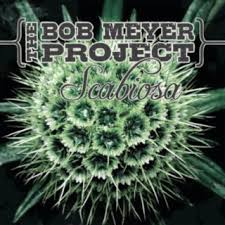
Daily Dose Of Jazz…
Bob Meyers was born on March 31, 1945 in Courtlandt Manor, New York. His early influences were classical and chamber music. When he was five he first heard the music of Kenny Clarke, Charlie Parker, Dizzy Gillespie and Thelonious Monk. It was at that age he began his music studies.
He attended George Washington University in Washington, DC earning his BA in History with minors in Music and Geology. He went on to study with Jack DeJohnette, Frank Dunlop, Henry Adler and Jim Chapin as well as extensive private study as an adult.
As an educator he has taught on both coasts focusing on technique, mechanics, musical application and interpretation on the drum set. Though specializing in jazz many of his students have gone on to be professionally active in jazz, rock and funk.
He has performed with Joe Lovano, John Abercrombie, Judi Silvano, Sheila Jordan, Ray Nance, Jaki Byard, Julian Priester, Gary Peacock, Diane Schurr, Mal Waldron, Kirk Lightsey, Avishai Cohen, Essiet Essiet, Santi Debriano and Vic Juris among numerous others.
As a leader he has recorded eighteen records. Drummer Bob Meyers continues to teach and perform as a leader and a sideman.
More Posts: bandleader,drums,history,instrumental,jazz,music
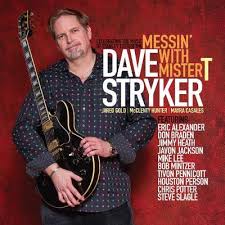
Daily Dose Of Jazz…
Dave Stryker was born March 30, 1957 and grew up in Omaha, Nebraska. At ten years old he was inspired by the Beatles to start playing guitar. His interest was rock and roll until he heard the albums My Favorite Things by John Coltrane and Beyond the Blue Horizon by George Benson. By seventeen, he was a jazz guitarist in town.
In 1978 he moved to Los Angeles, California where he took lessons from another Omaha native, Billy Rogers, and met organist Jack McDuff. After moving to New York City, he toured with McDuff in 1984 and1985, then spent ten years with saxophonist Stanley Turrentine.
Forming a band with Steve Slagle and a trio with Jared Gold and Tony Reedus he went on to work with Kevin Mahogany as sideman, composer, and arranger. Dave appeared with him at Carnegie Hall, and toured with him in Europe and Japan. He has also worked with Eliane Elias, Javon Jackson, and Andy LaVerne.
As an educator he teaches jazz guitar at Indiana University, Montclair State University, at the Jamey Aebersold Summer Jazz Workshop, the Litchfield Jazz Camp, and the Veneto/New School Workshop in Italy.
He recorded 38 albums as a leader, 5 with the Stryker/Slagle band, 2 with Trio Mundo and as a sideman he recorded 34 albums with Jared Gold, Steve Slagle, Allan Botschinsky, Don Braden, Kendall “Keyz” Carter, Rondi Charleston, Royce Campbell, Mike Freeman, Spellbound, Giacomo Gates, Craig Handy, Javon Jackson, Matthew Kaminski, Andy LaVerne, Pete Levin, Kevin Mahogany, Jorge Nila, Tony Reedus, Larry Schneider, Stanley Turrentine, Charenee Wade, and Matthew Whitaker.
Guitarist Dave Stryker, who has been named Top Ten Guitarists and Rising Star by Down Beat magazine, continues to perform and record.
More Posts: guitar,history,instrumental,jazz,music
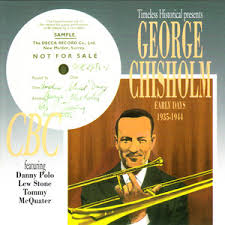
Daily Dose Of Jazz…
George Chisholm was born on March 29, 1915 in Glasgow, Scotland and at the age of fifteen in the late 1930s he moved to London, where he played in dance bands led by Bert Ambrose and Teddy Joyce. He later recorded with jazz musicians such as Coleman Hawkins, Fats Waller and Benny Carter during their visits to the UK.
During the Second World War, he signed on with the Royal Air Force and joined the RAF Dance Orchestra, known popularly as the Squadronaires, remaining in the band long after he was demobbed. George followed this with freelance work and a five-year stint with the BBC Showband, the forerunner of the BBC Radio Orchestra. As a core member of Wally Stott’s orchestra on BBC Radio’s The Goon Show, he made several minor acting appearances.
He had roles in the films The Mouse on the Moon, The Knack …and How to Get It and Superman III. He was part of the house band for the children’s programs Play School and Play Away. He also sang and was a storyteller on Play School occasionally.
During the 1980s despite undergoing heart surgery, Chisholm continued to play, working with his own band the Gentlemen of Jazz and Keith Smith’s Hefty Jazz among others, and playing live with touring artists.
By the mid-1990s he retired from public life suffering from Alzheimer’s disease. Trombonist and vocalist George Chisholm, who was appointed as an Officer of the British Empire (OBE), died on December 6, 1997 at the age of 82.
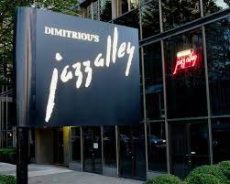
The Jazz Voyager
The Jazz Voyager is crisscrossing the country once again and this week is heading to the Emerald City for this week’s destination. The club I will be relishing to the sounds of jazz is Dimitriou’s Jazz Alley, and it is located in downtown Seattle, kitty corner to the Amazon Spheres where 40,00 plants from over thirty countries are housed. The atmosphere within this small venue is a cozy bi-level 350 seats that puts me between five to 50 fifty feet from the stage.
This evening of music entertainment is with Madeleine Peyroux, who spent her teenage years busking the busy streets of Paris, France. Befriending the city’s street musicians she made its Latin quarter her first performing stage. Years later in 1996, her breakthrough album Dreamland sold a striking 200,000 copies and Madeleine’s dusky voice was likened to that of jazz greats Billie Holiday and Ella Fitzgerald.
The venue is located at the corner of Lenora Street at 2033 6th Avenue, Seattle, WA 98121. For those who want more info go to https://notoriousjazz.com/event/madeleine-peyroux-2.
More Posts: adventure,club,genius,jazz,music,preserving,travel,vocal



